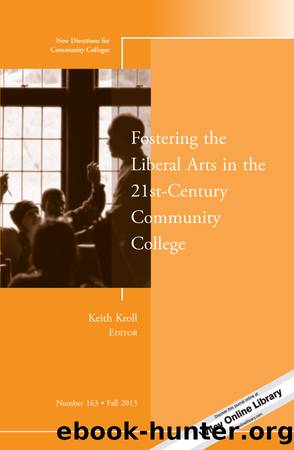Fostering the Liberal Arts in the 21st-Century Community College by Kroll Keith;

Author:Kroll, Keith;
Language: eng
Format: epub
Publisher: John Wiley & Sons, Incorporated
Published: 2013-11-01T00:00:00+00:00
Image and Place: The Fourth Dimension in 3-D
Community College historians have utilized a variety of innovative strategies to enhance student perception of the fourth dimensionâtimeâin introductory surveys.
Images.
The rich array of primary source documents on the Internet, from websites such as the Internet History Sourcebook Project (http://www.fordham.edu/halsall/), the Roy Rosenzweig Center for History and New Media (http://chnm.gmu.edu/), or the Gilder Lehrman Institute of American History (http://www.gilderlehrman.org/collections), have opened endless possibilities for creative assignments that promote student research. Academic tasks that demand high literacy skills may nevertheless be initially intimidating to some community college students who enroll with developmental needs or who are non-native English speakers. For many students, the imageâaccessible through media and recreational computer useâhas become far more familiar and comfortable as a source of information than the word (Coohill, 2006). Images can enable students to, in Peter Burke's (2001) phrase, â âimagineâ the past more vividlyâ (p. 13), proving particularly useful as a means to invite students to appreciate what Andrews and Burke (2007) have termed âthe five Cs of historical thinking ⦠change over time, causality, context, complexity, and contingencyâ (para. 2).
One assignment this author has devised invites students to appreciate historical change by reviewing and reflecting, in an online writing assignment, on the contrast between two images of Venice: the first presented in Vittore Carpaccio's Miracolo della reliqua della croce al ponte di Rialto, the Miracle of the Relic of the Holy Cross at the Rialto Bridge, a picture dated to c. 1494â1496, and a contemporary postcard image of the Rialto Bridge in Venice (Tai, in press). Portraits, sculpture, and narrative European painting, introduced into a survey of Western Civilization from the medieval period to the Enlightenment, illustrate such developments as secularism in the Italian Renaissance or the growing divisions between rich and poor in the early modern period. Although this author has used books and postcard illustrations in classrooms without Internet access, presentation software can allow instructors to use Internet image banks such as the Library of Congress's American Memory collection (http://memory.loc.gov/ammem/index.html) or various world art museum websites.
Download
This site does not store any files on its server. We only index and link to content provided by other sites. Please contact the content providers to delete copyright contents if any and email us, we'll remove relevant links or contents immediately.
Fangirl by Rainbow Rowell(8808)
How to Bang a Billionaire by Alexis Hall(7942)
Wonder by R. J. Palacio(7750)
The Space Between by Michelle L. Teichman(6589)
The Thirst by Nesbo Jo(6458)
Assassin’s Fate by Robin Hobb(5867)
Wiseguy by Nicholas Pileggi(5335)
The Night Circus by Erin Morgenstern(5044)
The Kite Runner by Khaled Hosseini(4963)
Paper Towns by Green John(4815)
Bittersweet (True North #1) by Sarina Bowen(4720)
Gerald's Game by Stephen King(4386)
Too Much and Not the Mood by Durga Chew-Bose(4105)
Pillow Thoughts by Courtney Peppernell(4039)
Goodbye Paradise(3464)
Twelve Days of Christmas by Debbie Macomber(3421)
Good by S. Walden(3361)
The Rosie Effect by Graeme Simsion(3223)
The Cellar by Natasha Preston(3081)
